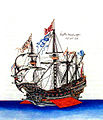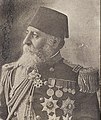Ottoman Navy
This articleneeds additional citations forverification.(June 2010) |
| Ottoman Navy | |
|---|---|
| Turkish:Osmanlı Donanması | |
 | |
| Active | 1323–1922 |
| Country | |
| Allegiance | |
| Type | Navy |
| Garrison/HQ | Ministry of the Navy,Constantinople |
| Engagements | |
| Commanders | |
| Kapudan Pasha (1567–1867) |
|
| Minister of the Navy (1867–1922) |
|
| Fleet Commander (1877–1922) |
|
| Military of the Ottoman Empire |
|---|
 |
TheOttoman Navy(Turkish:Osmanlı Donanması) orThe Imperial Navy(Ottoman Turkish:Donanma-yı Humâyûn), also known as theOttoman Fleet,was thenaval warfare armof theOttoman Empire.It was established after the Ottomans first reached the sea in 1323 by capturing Praenetos (later calledKaramürselafter the founder of the Ottoman Navy), the site of the first Ottomannaval shipyardand the nucleus of the future navy.
During its long existence, the Ottoman Navy wasinvolved in many conflictsand signed a number of maritime treaties. It played a decisive role in theconquest of Constantinopleand the subsequent expansion into the Mediterranean and Black Seas. At its height in the 16th century, the Navyextended to the Indian Ocean,sending anexpedition to Indonesiain 1565, and by the early 17th century operated as far as theAtlantic.Commensurate with thedecline and modernization of the empirein the late 18th century, the Ottoman Navy stagnated, albeit remaining among the largest in the world: with nearly 200 warships, including 21 battleships, it ranked third after the British and French navies.[1]
For much of its history, the Navy was led by theKapudan Pasha(Grand Admiral; literally "Captain Pasha" ); this position was abolished in 1867, when it wasreplacedby the Minister of the Navy (Turkish:Bahriye Nazırı) and a number ofFleet Commanders(Turkish:Donanma Komutanları).
After theend of the Ottoman Empireand the declaration of theRepublic of Turkeyin 1923, the Navy's tradition was continued under the modernTurkish Naval Forces.
History
[edit]Pre-Ottoman Turkish fleets
[edit]The first Turkish naval fleet inAnatolia,which consisted of 33 sail ships and 17 oar ships, was formed at the port ofSmyrna(İzmir) byTzachasin 1081, following his conquest of Smyrna, Vourla (Urla), Kysos (Çeşme),Phocaea(Foça) and Teos (Sığacık) on the Aegean coast of Anatolia in that same year. Tzachas's fleet raidedLesbosin 1089 andChiosin 1090, before defeating aByzantine fleetnear theOinousses Islandsoff Chios on 19 May 1090, which marked the first major naval victory of the Anatolian Turks in a naval battle. In 1091 Tzachas's fleet raided the islands ofSamosandRhodesin theAegean Sea,but was then defeated and driven out by theByzantineadmiralsConstantine DalassenosandJohn Doukas.In 1095 Tzachas's fleet raided the strategic port city and Gulf of Adramyttium (Edremit) on the Aegean coast of Anatolia and the city ofAbydoson theDardanellesStrait.[citation needed]
Seljuq sultan of RûmKayqubad IconqueredAlaiye(Alanya) and formed a naval arsenal there. Alanya became the homeport of the Seljuk fleet in theMediterranean Sea.Kayqubad I later formed a fleet in theBlack Seabased in Sinope (Sinop), which, under the command ofAmir Chupan,conquered parts of theCrimean PeninsulaandSugdakon theSea of Azov(1220–1237).[citation needed]
Rise (1299–1453)
[edit]Expansion to the Aegean, Black, Ionian and Adriatic Seas
[edit]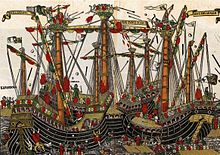
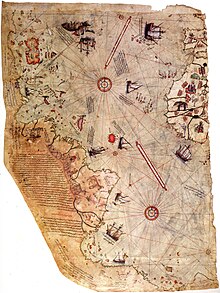
The conquest of the island of Kalolimno (İmralı Island) in theSea of Marmarain 1308 marked the first Ottoman naval victory. The Ottoman fleet made its first landings onThracein 1321. The first Ottoman fortress in Europe was built in 1351, and the Anatolian shores of the strategicBosporusStrait nearConstantinoplein 1352, and both shores of the equally strategicDardanellesStrait were conquered by the Ottoman fleet.
In 1373 the first landings and conquests on theAegeanshores ofMacedoniawere made, which was followed by the first Ottoman siege ofThessalonikiin 1374. The first Ottoman conquest of Thessaloniki and Macedonia were completed in 1387. Between 1387 and 1423 the Ottoman fleet contributed to the territorial expansions of the Ottoman Empire on the Balkan peninsula and the Black Sea coasts of Anatolia. Following the first conquests ofVenetianterritories inMorea,the first Ottoman-Venetian War (1423–1430) started.
In the meantime, the Ottoman fleet continued to contribute to the expansion of the Ottoman Empire in the Aegean and Black Seas, with the conquests ofSinop(1424),Smyrna(1426) and the reconquest of Thessaloniki from the Venetians (1430).Albaniawas reconquered by the Ottoman fleet with landings between 1448 and 1479.
Growth (1453–1683)
[edit]In 1453 the Ottoman fleet participated in the historic conquests ofConstantinople,Gökçeada,LemnosandThasos.The conquest of theDuchy of Athensand theDespotate of the Moreawas completed between 1458 and 1460, followed by the conquest of theEmpire of Trebizondand theGenoesecolony ofAmasrain 1461, which brought an end to the final vestiges of theByzantine Empire.In 1462 the Ottoman fleet conquered the Genoese islands of the northern Aegean Sea, which were administered by theGattilusio family,includingtheir capital Mytilenein the island ofLesbos.This was followed by theOttoman-Venetian War of 1463–1479.
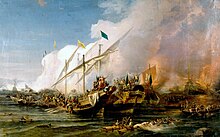
In the following period the Ottoman fleet gained more territory in the Aegean Sea, and in 1475 set foot onCrimeaon the northern shores of theBlack Sea.Until 1499 this was followed by further expansion on the Black Sea coasts (such as the conquest of Georgia in 1479) and on the Balkan peninsula (such as the final reconquest of Albania in 1497, and the conquest of Montenegro in 1499). The loss of Venetian forts in Montenegro, near the strategicCastelnuovo,triggered theOttoman-Venetian War of 1499–1503,during which the Turkish fleet ofKemal Reisdefeated the Venetian forces at theBattle of Zonchio(1499) and theBattle of Modon(1500). By 1503 the Ottoman fleet raided the northeasternAdriaticcoasts ofItaly,and completely captured the Venetian lands onMorea,theIonian Seacoast and the southeasternAdriatic Seacoast.
According toKâtip Çelebia typical Ottoman fleet in the mid-17th century consisted of 46 vessels (40 galleys and 6 maona's) whose crew was 15,800 men, roughly two-thirds (10,500) were oarsmen, and the remainder (5,300) fighters.[2]
Expansion to the Levant and Maghreb, operations in the West Mediterranean
[edit]


Starting from the conquest ofSyriain 1516, the Ottoman fleet ofSelim Istarted expanding the Ottoman territories towards theLevantand theMediterraneancoasts ofNorth Africa.Between 1516 and 1517Algeriawas conquered from Spain by the forces ofOruç Reis,who declared his allegiance to the Ottoman Empire, which was followed by the conquest ofEgyptand the end of theMameluke Empirein 1517. In 1522 the strategic island ofRhodes,then the seat of theKnights of St. John,was conquered by the naval fleet ofKurtoğlu Muslihiddin Reis;Suleiman Ilet the Knights leave the island, and they relocated their base first to Sicily and later to Malta.
In 1527 the Ottoman fleet participated in the conquest ofDalmatia,Croatia,Slavonia,andBosnia.In 1529 the Ottoman fleet underSalih ReisandAydın Reisdestroyed the Spanish fleet of Rodrigo Portundo near the Isle ofFormentera.This was followed by the first conquest ofTunisiafrom Spain and the reconquest ofMoreaby the forces ofHayreddin Barbarossa,whose fleet later conquered the islands belonging to theDuchy of Naxosin 1537. Afterwards, the Ottoman fleet laid siege on the Venetian island ofCorfu,and landed on the coasts ofCalabriaandApulia,which forced theRepublic of VeniceandHabsburg Spainruled byCharles Vto ask the Pope to create aHoly Leagueconsisting of Spain, the Republic of Venice, theRepublic of Genoa,thePapal Statesand theKnights of Malta.The joint fleet was commanded by Charles V's leading admiral,Andrea Doria.The Holy League and the Ottoman fleet under the command of Hayreddin Barbarossa met in September 1538 at theBattle of Preveza,which is often considered the greatest Turkish naval victory in history. In 1543 the Ottoman fleet participated with French forces in thesiege of Nice,which at the time was part of the Duchy of Savoy. Afterwards,Francis I of Franceenabled the Ottoman fleet to overwinter in the French harbor ofToulon.This uniqueOttoman wintering in Toulon(sometimes inaccurately called an occupation; the Ottomans merely stayed the winter and did not impose any form of governance on the populace) allowed the Ottomans to attack Habsburg Spanish and Italian ports (enemies of France); they left Toulon in May 1544.Matrakçı Nasuh,a 16th-century OttomanJanissary,polymath,andswordmaster,reportedly participated in the wintering in Toulon.[citation needed]
In 1541, 1544, 1552 and 1555, the Spanish-Italian fleet of Charles V under the command of Andrea Doria was defeated inAlgiers,Naples,Ponza,andPiombino,respectively.
Operations in the Indian Ocean and the final conquests in North Africa
[edit]

In the meantime, the Ottoman Indian Ocean Fleet, based inSuezandBasra,defeated thePortugueseforces on several occasions near theArabian peninsula,conqueringAdenandYemen(1538–1539) which were important Portuguese ports, along withJeddah,Djiboution theRed Seacoast. The Ottomansiege of Diuin 1538, which aimed to remove the Portuguese fromIndia,failed to achieve this goal.
Between 1547 and 1548, Yemen was reconquered from the Portuguese, while in thePersian GulfandArabian Sea,other important Portuguese ports such asOmanandQatarwere conquered in 1552,[3]but the Ottomans failed to takeHormuz Islandand therefore the control of the Persian Gulf remained firmly in Portuguese hands.[4]
In 1565 theSultanate of AcehinSumatra(Indonesia) declared allegiance to the Ottoman Empire, and in 1569 the Ottoman fleet ofKurtoğlu Hızır Reissailed to new ports such asDebal,Surat,Janjiraand finally set foot onAcehwith awell-equipped fleet of 22 ships,which marked the easternmost Ottoman territorial expansion.
The Ottoman naval victory at theBattle of Prevezain 1538 and theBattle of Djerbain 1560 ensured the Ottoman supremacy in the Mediterranean Sea for several decades, until the Ottomans suffered their first ever military defeat at the hands of the Europeans at theBattle of Lepanto (1571).But the defeat at Lepanto, despite being much celebrated in Europe, was only a temporary setback: it could not reverse the Ottomanconquest of Cyprus,and within a year, the Ottomans built an equally large fleet, which in 1574conquered Tunisiafrom Spain. This completed the Ottoman conquest ofNorth Africa,following the operations of the Ottoman fleet underTurgut Reiswhich had earlier conqueredLibya(1551); and of the fleet underSalih Reiswhich had conquered the coasts ofMoroccobeyond theStrait of Gibraltarin 1553.
Operations in the Atlantic Ocean
[edit]Starting from the early 17th century, the Ottoman fleet began to venture into the Atlantic Ocean (earlier,Kemal Reishad sailed to theCanary Islandsin 1501, while the fleet ofMurat Reis the Elderhad capturedLanzaroteof theCanary Islandsin 1585).[5]In 1617 the Ottoman fleet capturedMadeirain the Atlantic Ocean, before raidingSussex,Plymouth,Devon,Hartland Point,Cornwalland the other counties of western England in August 1625.[5]In 1627 Ottoman naval ships, accompanied byBarbary corsairsunder the leadership ofMurat Reis the Younger,captured the Isle ofLundyin theBristol Channel,which served as the main base for Ottoman naval and privateering operations in the North Atlantic for the next five years.[6]They raided theShetland Islands,Faroe Islands,Denmark-Norway,IcelandandVestmannaeyjar.[5][7][8]Between 1627 and 1631 the same Ottoman force also raided the coasts ofIrelandandSweden.[5][9][10]Ottoman ships later appeared off the eastern coasts of North America, particularly being sighted at the English colonies likeNewfoundlandandVirginia.[5]
Black Sea operations
[edit]

Before the Ottomans, theSeljuq sultan of Rûm,Alaeddin Keykubad I,had formed aBlack Seafleet based inSinop,which, under the command ofAmir Chupan,had conquered parts of theCrimean peninsulaandSugdakon theSea of Azovbetween 1220 and 1237.
In the years following theirconquest of Constantinoplein 1453, the Ottoman Turks had dominated theMediterraneanwith their fleets ofgalleys.In 1475, the Ottoman sultanMehmed IIemployed 380 galleys under the command ofGedik Ahmet Pasha,whose fleet conquered theGreekPrincipality of Theodorotogether with theGenoese-administeredCrimeanport towns ofCembalo,Soldaia,andCaffa( "Kefe" in Turkic languages.)[11]As a result of these conquests, starting from 1478, theCrimean Khanatebecame avassal stateandprotectorateof the Ottoman Empire, which lasted until 1774.
The failure of thesiege of Maltain 1565 and the victory of the Holy League navies over the Ottomans at theBattle of Lepantoin 1571 indicated that the pendulum was beginning to swing the other way,[12]but theBlack Seawas, for a time, regarded as a "Turkish Lake".[13]For over a hundred years Ottoman naval supremacy in the Black Sea rested on three pillars: the Ottoman Turks controlled theTurkish Straitsand the mouth of theDanube;none of the states in the region could muster an effective naval force; and the virtual absence ofpiracyon the Black Sea.[13]However, after the 1550s, it was the start of frequent naval raids byZaporozhian Cossacksthat marked a major change in control of the Black Sea.[13]The Cossacks' keelless rowing boats, calledchaikas,could accommodate up to seventy men and outfitted withcannonades,the boats made formidable sea vessels. They had the advantage over the Ottoman galleys in that being small, and low in the water, they were difficult to spot and highly manoeuvrable. In the early 1600s the Cossacks were able to assemble fleets of up to 300 such boats and send them to every corner of the Black Sea.[13]They began attacking large towns such asCaffa,Varna,Trabzon,and even the suburbs ofConstantinople.[14]
Guillaume Levasseur de Beauplan,a French military engineer, provided a first-hand account of the Cossack operations and their tactics against the Turkish ships and towns on the Black Sea Coast.[13][15]The high point of the Cossack attacks came in 1637, when a large party of Zaporozhian andDon Cossackslaid siege to the fortress ofAzov.After a two-month land and sea battle, the fortress was conquered by the Cossacks.[13]
The Ottoman Navy also engaged in blockades ofGeorgia's western coast during the sixteenth and seventeenth centuries in order to coerce local kingdoms into submission.
Stagnation (1683–1827)
[edit]In the rest of the 17th and 18th centuries, however, the operations of the Ottoman fleet were largely limited to theMediterranean Sea,Black Sea,Red Sea,Persian Gulfand theArabian Sea.The long lastingOttoman-Venetian War of 1645–1669ended with Ottoman victory and the completion of the conquest ofCrete,marking the Empire's territorial zenith. In 1708 another long-lasting objective, the conquest ofOran(the final Spanish stronghold inAlgeria) was accomplished.

The 18th century was a period of stalemate for the Ottoman fleet, with numerous victories matched by equally numerous defeats. Important Ottoman naval victories in this period included the reconquest ofMoldaviaandAzovfrom theRussiansin 1711. TheOttoman–Venetian War of 1714–1718saw the reconquest of Morea from the Venetians and the elimination of the last Venetian island strongholds in the Aegean.
For most of the 18th century, during a period of time in the eastern Mediterranean known by some as the Pax Ottomana, the focus of the Ottoman Navy was both on defining and defending its territorial waters from rival states and enforcing its authority over them as well as increasingly on protecting international trade routes and defending its maritime commerce from the constant problem of piracy.[16]
However, during theRusso-Turkish War of 1768–1774,the Ottoman fleet was destroyed in theBattle of Chesme(1770). The nextRusso-Turkish War(1787–1792) again saw numerous naval defeats at the hands of the RussianBlack Sea Fleetunder AdmiralFyodor Ushakov.
During theGreek War of Independence(1821–1829), the Greek rebel navy consisting of converted merchant ships originally challenged Ottoman naval supremacy in the Aegean, blockading Ottoman forts in the Morea and contributing to their capture by Greek land forces. Following the intervention of theOttoman eyalet of Egyptin 1824, the far superior Ottoman-Egyptian fleet under the command ofIbrahim Pashagained the upper hand and successfully invaded Crete and the Morea until the arrival of the combinedBritish-French-Russianfleets which destroyed most of the Ottoman-Egyptian naval force at theBattle of Navarinoin 1827.
| Size of crew in Ottoman ships in 1699 and 1738[17] | ||||||||||||||||||||
|---|---|---|---|---|---|---|---|---|---|---|---|---|---|---|---|---|---|---|---|---|
| Size of crew | ships in 1699 | ships in 1738 | ||||||||||||||||||
| 1500 | - | 1 | ||||||||||||||||||
| 1300 | - | 1 | ||||||||||||||||||
| 1100 | - | 1 | ||||||||||||||||||
| 1000 | - | 1 | ||||||||||||||||||
| 800 | - | 6 | ||||||||||||||||||
| 750 | - | 5 | ||||||||||||||||||
| 650 | - | 4 | ||||||||||||||||||
| 600 | 1 | - | ||||||||||||||||||
| 500 | - | 1 | ||||||||||||||||||
| 450 | - | 7 | ||||||||||||||||||
| 400 | 2 | 3 | ||||||||||||||||||
| 350 | 3 | 1 | ||||||||||||||||||
| 300 | 8 | 1 | ||||||||||||||||||
| 250 | 3 | 1 | ||||||||||||||||||
| 200 | 3 | - | ||||||||||||||||||
| Total | 20 | 33 | ||||||||||||||||||
| Note: Between 1699 and 1738 the Ottoman navy started to use more sailing ships who needed more crew on each ship instead of galleys with less men. | ||||||||||||||||||||
Danube fleet
[edit]The size of theDanubefleet of the Ottoman Navy at the time of theGreat Turkish Warin the late 17th century was 52 vessels (4galliots,28frigatesand 20 flat-bottomed river boats) manned by 4,070 crew.[18]
Decline (1827–1908)
[edit]



The 19th century saw further decline in Ottoman naval power, despite occasional recovery. Following the defeat against the combined British-French-Russian fleet at theBattle of Navarinoin 1827, SultanMahmud IIgave priority to develop a strong and modern Ottoman naval force. The first steam ships of the Ottoman Navy were acquired in 1828. In 1829 the world's largest warship for many years, the 201 x 56kadem(1kadem= 37.887 cm[22]) or 76.15 m × 21.22 m (249.8 ft × 69.6 ft)ship of the lineMahmudiye,which had 128 cannons on 3 decks and carried 1,280 sailors on board, was built for the Ottoman Navy at theImperial Arsenalon theGolden HorninConstantinople.In the 1830s, about 2.500 Christian sailors (mainly Armenians and Greeks) were recruited in the Ottoman navy. This caused negative reactions from the Christian communities. Many Greeks from Rhodos and Chios fled to the neighboring smaller islands. In 1847, Christian sailors demanded their own priests and chapels on the warships, which was refused on the basis of Sharia. The Great Admiral and the GreatVizierwere in favour of the Christians' demands, but the Sheih ul-Islam declared that Christian services on board were equivalent to the construction of new churches, and thus forbidden by religious law.[23]
In 1875, during the reign of SultanAbdülaziz,the Ottoman Navy had 21 battleships and 173 other types of warships, ranking as the third largest navy in the world after the British and French navies. But the vast size of the navy was too much of a burden for thecollapsing Ottoman economyto sustain. Abdülhamid II was aware that the empire needed a navy to shield herself from the ever-growing Russian threat. However, the Ottoman economic crisis of 1875 and the additional financial burden of the disastrousRusso-Turkish War (1877–1878)deprived the Ottoman Empire from the financial resources andeconomic independenceto maintain and modernize a large fleet. The second half of the 19th century was a period of breakthroughs in the field of naval engineering. The Ottoman Navy was rapidly becoming obsolete, and needed to replace all her warships once a decade to keep up with the pace in technological progress – which, given the dismal state of the economy, was clearly not an option.
Nordenfelt-class Ottoman submarineAbdül Hamid(1886) was the firstsubmarinein history to fire atorpedowhile submerged under water.[24]Two submarines of this class,Nordenfelt II(Abdül Hamid,1886) andNordenfelt III(Abdül Mecid,1887) were built for the Ottoman Navy. They were built in pieces by Des Vignes (Chertsey) and Vickers (Sheffield) in England, and assembled at the Taşkızak Naval Shipyard in Constantinople (Istanbul). These submarines were an attempt to gain an edge over the Greek navy (which had only one Nordenfelt submarine, a smaller and older version). However, it was quickly realized that – like the other Nordenfelt submarines ordered by Russia – they suffered from stability problems and were too easy to swamp on the surface. The Turks could not find a crew that was willing to serve on the primitive submarines.Abdül Hamidended up rotting at dock, whileAbdül Mecidwas never fully completed.[25]
Dissolution (1908–1922)
[edit]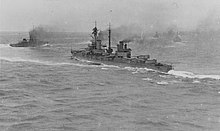

Following theYoung Turk Revolutionin 1908, theCommittee of Union and Progresswhich effectively took control of the country sought to develop a strong Ottoman naval force. The poor condition of the fleet became evident during the Ottoman Naval Parade of 1910, and theOttoman Navy Foundationwas established by the Ottoman government in order to purchase new ships through public donations. Those who made donations received different types of medals according to the size of their contributions.
In 1910, the Ottoman Navy purchased twopre-dreadnought battleshipsfrom Germany:SMSWeissenburgand her sister shipSMSKurfürst Friedrich Wilhelm.These ships were renamedTurgut ReisandBarbaros Hayreddin,respectively.
TheItalo-Turkish Warof 1911–1912 and theBalkan Warsof 1912–1913 proved disastrous for the Ottoman Empire. In the former, the Italians occupiedOttoman Tripolitania(present-dayLibya) and theDodecanese Islandsin the Aegean Sea and theRegia Marinadefeated Ottoman light naval forces in the battles ofPreveza,BeirutandKunfuda Bay.In the latter, a smaller Greek fleet successfully engaged with Ottoman battleships in the naval skirmishes ofElliandLemnos.The better condition of the Greek fleet in the Aegean Sea during the Balkan Wars led to the liberation of all Ottoman-heldAegean islandsother than those in the Italian-occupied Dodecanese. It also prevented Ottoman reinforcements and supplies to the land battles on the Balkan peninsula, where theBalkan Leagueemerged victorious. The only Ottoman naval successes during the Balkan Wars were the raiding actions of the light cruiserHamidiyeunder the command ofRauf Orbay.


In the aftermath of the Balkan Wars, the Ottomans remained engaged in a dispute over the sovereignty of theNorth Aegean islandswith Greece. A naval race ensued in 1913–1914, with the Ottoman Navy ordering largedreadnoughtbattleshipslikeSultan Osman-ı EvvelandReşadiyewith the aforementioned public donations made to the Ottoman Navy Foundation. Although the Ottoman government had fully completed the payments for both battleships and sent a Turkish delegation to theUnited Kingdomto collect them after the completion of their sea trials, the British government confiscated them at the outbreak of theFirst World Warin August 1914 and renamed them asHMSAgincourtandHMSErin.This caused considerable ill-feeling towards Britain among the Ottoman public, and theGerman Empiretook advantage of the situation when thebattlecruiserSMSGoebenandlight cruiserSMSBreslauarrived at theDardanellesand entered service in the Ottoman Navy asYavuz Sultan SelimandMidilli,respectively. These events significantly contributed to thePorte's decision toenter the First World Waron the side of theCentral Powers.However, Germany and the Ottomans had already signed a secret alliance, theOttoman-German allianceon 2 August 1914, before the British naval seizures.
World War I and aftermath
[edit]The Ottomans' first military action in theFirst World Warwas theBlack Sea raidand was a surprise attack by the Ottoman Navy on the Russian Black Sea coast on 29 October 1914. The naval raid prompted Russia and its allies, Britain and France, to declare war on the Ottoman Empire in November 1914. During WWI, the Ottoman Navy engaged the Entente Powers in the Mediterranean and Black Sea.


In 1915 at theBattle of Gallipoli,theBritishandFrenchfleets failed to pass through theDardanelles Strait(Çanakkale Boğazı) thanks to the heavy Turkish fortifications lining the Strait, mining by Turkish minelayers likeNusret,and fierce fighting by the Turkish soldiers on land, sea and air.[26][page needed]During the battle, the British submarineHMSE11sankBarbaros Hayreddinon 8 August 1915.
In the last year of World War I, while returning from a bombardment mission of the Allied port ofMudroson the Greek island ofLemnos,Midilliran into a minefield between Lemnos andGökçeadaon 20 January 1918, and sank after being severely damaged by five consecutive mine hits. During the mission,Midilli,together withYavuz Sultan Selim,had managed to sink the British warshipsHMSRaglanandHMSM28,as well as a 2,000-ton transport ship, and hadbombarded the port of Mudros,together with the communication posts and air fields of the Entente on the other parts of Lemnos. The battlecruiserYavuz Sultan Selimbecame one of the most active Ottoman warships throughout the First World War; she bombarded numerous ports on theBlack SeaandAegean Sea,while engaging with Russiandreadnoughtbattleships of theImperatritsa Mariyaclassand sinking a number of Russian and British warships and transport vessels.[citation needed]

Following the end ofWorld War I,the victorious Entente dissolved the Ottoman Navy and the large ships of the Ottoman fleet were towed to thePrince Islandsin theSea of Marmaraunder the control of Allied warships, or locked inside theGolden Horn.Some of them were scrapped[citation needed].
After the independence of theRepublic of Turkeyin 1923, the remaining major warships of the former Ottoman fleet, such as thebattlecruiserTCGYavuz,thepre-dreadnought battleshipTCGTurgut Reis,protected cruisersTCGHamidiyeandTCGMecidiye,torpedo cruisersBerk-i SatvetandPeyk-i Şevket,destroyersTCGSamsun,TCGBasraandTCGTaşoz,andtorpedo boatsTCGBurak Reis,TCGKemal Reis,TCGÎsâ ReisandTCGSakızwere overhauled, repaired and modernized in the 1920s, while new ships and submarines were acquired starting from the early 1930s.
Admirals
[edit]

Famed Ottoman admirals include:
- Kemal Reis,who twice defeated theVenetianfleet at theFirst Battle of Lepantoin 1499 and theSecond Battle of Lepantoin 1500
- Hayreddin Barbarossa,who defeated the fleet of the Holy League ofCharles Vunder the command ofAndrea Doriaat the island ofPeñónin 1531,Battle of Prevezain 1538 andAlgiersin 1541
- Turgut Reis(known asDragutin the West), who conqueredLibyain 1551 and defeated the fleet ofCharles Vunder the command ofAndrea Doriaat the Battle ofPonzain 1552
- Piyale Pasha,who defeated the Holy League ofPhilip II of Spainunder the command ofGiovanni Andrea Doriaat theBattle of Djerbain 1560
- Aruj,who established the Ottoman presence in North Africa which lasted four centuries
- Salih Reis,who conqueredMoroccoin 1553 and extended Ottoman territory into the Atlantic Ocean
- Uluç (Kılıç) Ali Reis,who restored the Ottoman domination of the Mediterranean after theThird Battle of Lepanto in 1571and conqueredTunisiafrom Spain in 1574
- Murat Reis,who fought thePortuguesein the Indian Ocean between 1552 and 1554 and capturedLanzaroteof theCanary Islandsin the Atlantic Ocean in 1585
- Seydi Ali Reis(known as Sidi Ali Reis in the West), who fought the Portuguese in the Indian Ocean in 1554 and is famous for his books of travel which have been translated into many languages
- Kurtoğlu Muslihiddin Reis(known asCurtogoliin the West), who played an important role in the conquests ofEgyptin 1517 andRhodesin 1522, and established the Ottoman Indian Ocean Fleet based inSuezwhich was later commanded by his son,Kurtoğlu Hızır Reis,who led the Ottoman naval expedition toAceh(1568–1569) which marked the easternmost territorial expansion of theOttoman Empire
The Ottoman admiral and cartographerPiri Reiscrafted maps and books of navigation, includinghis first world map (1513)which is one of the oldest surviving maps ofAmericaand possibly the oldest surviving map ofAntarctica.The first world map (1513) and second world map (1528) of Piri Reis are today preserved at the Library ofTopkapı PalaceinIstanbul.Other works ofPiri Reisare preserved at theNaval MuseuminIstanbul.[27]
Istanbul Naval Museum
[edit]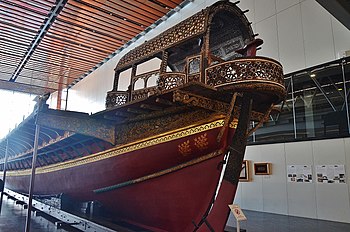
TheIstanbul Naval Museumis located in theBeşiktaşdistrict ofIstanbul,Turkey.It was established in 1897 by theOttomanMinister of the Navy (Bahriye Nazırı)Bozcaadalı Hasan Hüsnü Pasha.[32][33]
The museum contains an important collection of military artifacts pertaining to the Ottoman Navy.[32]In the maritime field, it is Turkey's largest museum, with a great variety of collections. Around 20,000 pieces are present in its collection, including the late 16th or early 17th century Ottoman Navygalleyknown asTarihi Kadırga,built in the period between the reigns of SultanMurad III(1574–1595) and SultanMehmed IV(1648–1687),[28][29]as evidenced byAMS radiocarbon datinganddendrochronological research.[29]She is the only surviving original galley in the world,[28][30]and has the world's oldest continuously maintained wooden hull.[31]
Being connected to the Turkish Naval Forces Command, it is also the country's first military museum.[34]
In the early 21st century a new exhibition building was constructed. The construction began in 2008, and the building was reopened on October 4, 2013. It has two floors above ground level and one basement floor, all covering 20,000 m2(220,000 sq ft).[34]
The basement consists of diverse items likefigureheads,ornaments of naval ships, ship models, and pieces of theByzantinechain that was used for blocking the entrance of theGolden Hornduring theOttoman conquest of Constantinople (Istanbul)in 1453. In the first and second floors, a large number of imperial and othercaïquesare exhibited.
Many exhibition items underwent special restoration and conservation works due to deformation of the raw materials caused by heat, light, humidity, atmospheric conditions, vandalism and other factors.[34]
Gallery
[edit]-
"Göke" (1495) was the flagship ofKemal Reis
-
Ali Osman Pasha
-
Halil Pasha (1910)
-
Fuat Hüsnü Kayacan
-
Naval uniform (1909–1916)
-
Naval uniform (1909–1916)
-
Naval uniform (1916–1925)
-
Naval uniform (1916–1925)
-
Muzaffer Adil Bey
Ships
[edit]- List of battleships of the Ottoman Empire
- List of cruisers of the Ottoman Navy
- List of major surface ships of the Ottoman steam navy
- List of mine warfare vessels of the Ottoman steam navy
- List of non-combat vessels of the Ottoman steam navy
- List of patrol vessels of the Ottoman steam navy
- List of sail frigates of the Ottoman Empire
- List of ships of the line of the Ottoman Empire
- List of wrecked or lost ships of the Ottoman steam navy
See also
[edit]- List of Ottoman sieges and landings
- List of Fleet Commanders of the Ottoman Navy
- List of Kapudan Pashas
- Turkish Navy
- The Ottomans: Europe's Muslim Emperors
References and sources
[edit]- ^Suciu, Peter (5 March 2022)."Turkey Could Be a Naval Power in Europe Again".The National Interest.Retrieved9 March2022.
- ^Ottoman Warfare 1500–1700, Rhoads Murphey, 1999, p. 23
- ^Peter Malcolm Holt, Ann K. S. Lambton, Bernard LewisThe Cambridge history of Islam1977.
- ^Soucek, Svat (June 2013),"Piri Reis. His uniqueness among cartographers and hydrographers of the Renaissance",in Vagnon, Emmanuelle; Hofmann, Catherine (eds.),Cartes marines: d'une technique à une culture. Actes du colloque du 3 décembre 2012.,CFC, pp. 135–144, archived fromthe original(PDF)on 27 June 2018,retrieved21 August2016
- ^abcdeTurkish Navy Official Website: "Atlantik'te Türk Denizciliği"[permanent dead link]Szkk.tsk.tr
- ^Konstam, Angus (2008).Piracy: the complete history.Osprey Publishing. p. 91.ISBN978-1-84603-240-0.
- ^Turkish Raid – anniversary exhibition in Westman Islands at 5 pmArchived22 July 2011 at theWayback Machine
- ^"Discover South Iceland - Vestmannaeyjar, The Westman Islands".Archive.is.24 July 2008. Archived fromthe originalon 24 July 2008.Retrieved20 July2011.
- ^"Barbary pirates in Ireland: The Sack of Baltimore, Co. (...)".Divainternational.ch.Retrieved11 May2019.
- ^"The O'Brien Press - The Stolen Village - Baltimore and the Barbary Pirates By Des Ekin".Obrien.ie.Retrieved11 May2019.
- ^Gábor Ágoston.Asia Minor and Beyond: The Ottomans.The Great Empires of Asia. Ed. Jim Masselos. Berkeley, Calif: University of California Press, 2010. p. 121ISBN978-0-520-26859-3
- ^"The Ottoman Navy".Naval Historical Society of Australia.6 September 1978.
- ^abcdefCharles King,The Black Sea: a History,Oxford University Press, 2004ISBN978-0-19-924161-3pp. 125, 131, 133–134
- ^Encyclopedia of the Ottoman Empire,Gábor Ágoston, Bruce Alan Masters (eds.) Infobase Publishing, 2009ISBN978-0-8160-6259-1p. 450
- ^"Guillaume Le Vasseur de Beauplan. Description d'Ukranie, qui sont plusieurs provinces du Royaume de Pologne".Litopys.org.ua.Retrieved11 May2019.
- ^Talbot, Michael (31 July 2017)."Protecting the Mediterranean: Ottoman Responses to Maritime Violence, 1718–1770".Journal of Early Modern History.21(4): 283–317.doi:10.1163/15700658-12342524.Retrieved2 November2022.
- ^Arming the State: Military Conscription in the Middle East and Central Asia, Erik J. Zurcher, p. 45
- ^Ottoman Warfare 1500-1700, Rhoads Murphey, 1999, p. 235
- ^Sondhaus, Lawrence (2001).Naval Warfare, 1815–1914.London: Routledge. p. 17.ISBN978-0-415-21478-0.
- ^abDaly, John C. K. (1991).Russian Seapower and 'the Eastern Question' 1827–41.Annapolis: Naval Institute Press. p. 69.ISBN1557507260.
- ^"Submarine Heritage Centre – Submarine History of Barrow-in-Furness".Submarineheritage.com.Archived fromthe originalon 4 July 2007.Retrieved11 May2019.
- ^kadem,which translates as "foot", is often misinterpreted as equivalent in length toone imperial foot,hence the wrongly converted dimensions of "201 x 56 ft, or 62 x 17 m" in some sources.
- ^Mehmet Hacısalihoğlu, "Inclusion and Exclusion: Conscription in the Ottoman Empire",J.of Modern European History,Vol. 5, No. 2 (2007), pp 266, 269
- ^"Submarine Heritage Centre – Submarine History of Barrow-in-Furness".Submarineheritage.com.Archived fromthe originalon 4 July 2007.Retrieved11 May2019.
- ^"The Invention of the Submarine".Archived fromthe originalon 19 December 2012.Retrieved6 July2007.
- ^See Massey,Castles of Steel
- ^"Turkish Naval Museum - Main Page".Archived fromthe originalon 26 February 2009.Retrieved20 July2011.
- ^abcd"The Historical Galley".denizmuzesi.dzkk.tsk.tr.24 November 2021.Archivedfrom the original on 8 October 2021.
- ^abcd"Liphschitz, N., 2014. The Kadirga galley in Istanbul – The Turkish Sultan's Caique: A dendrohistorical research. In: Environment and Ecology in the Mediterranean Region II (eds. R. Efe and M. Ozturk). Cambridge Scholars Pub. Pp.39-48. Cambridge".
- ^ab"Cornucopia Magazine".www.cornucopia.net.Retrieved16 March2022.
- ^ab"Center for Maritime Archaeology and Conservation - Texas A&M University".nautarch.tamu.edu.Retrieved24 November2021.
- ^abThe World of Learning 2004by Michael Salzman p.1670
- ^"Archived copy".Archived fromthe originalon 30 September 2012.Retrieved30 August2011.
{{cite web}}:CS1 maint: archived copy as title (link) - ^abc"Main Page".Deniz Müzeleri. Archived fromthe originalon 11 November 2014.Retrieved11 November2014.
Bibliography
[edit]- E. Hamilton Currey,Sea-Wolves of the Mediterranean(London, 1910).ISBN978-1500883430
- Bono, Salvatore:Corsari nel Mediterraneo(Corsairs in the Mediterranean) (Perugia, Oscar Storia Mondadori, 1993);Corsari nel Mediterraneo: Condottieri di ventura. Online database in Italian, based on Salvatore Bono's book.
- Bradford, Ernle,The Sultan's Admiral: The life of Barbarossa(London, 1968).ISBN978-1845117931
- Wolf, John B.,The Barbary Coast: Algeria under the Turks(New York, 1979).ISBN978-0393012057
- Melis, Nicola, "The importance of Hormuz for Luso-Ottoman Gulf-centred policies in the 16th century: Some observations based on contemporary sources", in R. Loureiro-D. Couto (eds.),Revisiting Hormuz – Portuguese Interactions in the Persian Gulf Region in the Early Modern Period(Wiesbaden, Harrassowitz, 2008, 107–120 (Maritime Asia, 19).
- Tuncay Zorlu,Innovation and Empire in Turkey: Sultan Selim III and the Modernisation of the Ottoman Navy(London, I.B. Tauris, 2011).ISBN978-1848857827
External links
[edit]- The Ottomans: Comprehensive and detailed online chronology of Ottoman history in English.
- Turkish Navy official website: Historic heritage of the Turkish Navy (in Turkish)
- Turkish Navy official website: Turkish seamen in the Atlantic Ocean (in Turkish)
- Istanbul Naval Museum Official Website
- History of the Ottoman Navy
- See World War I ship list Battleships-Cruisers.co.uk.
Representations in popular culture
[edit]- The Ottoman Navy and AdmiralHayreddin Barbarossaare depicted in the novelThe Sultan's Admiral: Barbarossa: Pirate and Empire BuilderbyErnle Bradford.
- The Ottoman Navy, AdmiralTurgut Reis,and the Siege of Malta are depicted in the novelThe ReligionbyTim Willocks.
- The Ottoman Navy and AdmiralKemal Reisare portrayed in the novelThe Sultan's Helmsmanby Robert Colburn.



